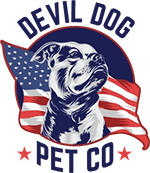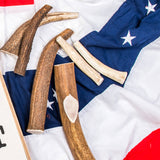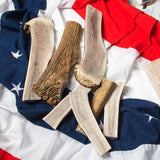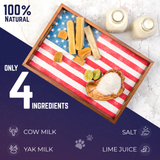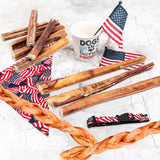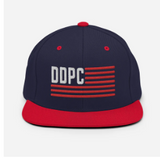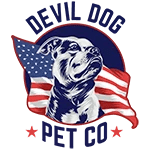Yak cheese isn't just another treat in the endless sea of dog chews—it's a game-changer for responsible owners who demand better. Made from hardened yak milk curds, these Himalayan-sourced chews deliver a protein-packed, long-lasting option that outperforms most alternatives on durability, digestibility, and dental benefits.
When our dog Dexter demolished his first yak chew over several days instead of minutes, I knew we'd found something special. The difference is clear: while most commercial treats prioritize flavor over function, yak cheese puts your dog's health first without sacrificing the satisfaction they crave.
Key Takeaways
- Yak cheese is a durable and long-lasting dog chew made from hardened yak milk curds sourced from the Himalayas.
- It offers a protein-rich alternative that supports better digestibility and dental health compared to many commercial treats.
- Yak cheese treats prioritize your dog's health without compromising on their enjoyment.
- These chews provide a more functional and satisfying option for responsible dog owners seeking quality treats.
Table of Contents
- Yak Cheese Benefits: Why Your Dog Deserves This Himalayan Powerhouse
- The Nutritional Powerhouse Behind Yak Cheese
- Dental Benefits That Make Veterinarians Smile
- Yak Cheese Benefits: Why These Chews Outperform The Competition
- Behavioral Benefits: How Yak Cheese Transforms Problem Chewers
- Finding Quality Yak Cheese: What Separates Premium From Pretenders
- Environmental Impact: How Yak Cheese Supports Sustainable Pet Care
- Comparing Yak Cheese to Other Premium Chew Options
- Conclusion: Why Yak Cheese Deserves a Place in Your Dog's Life
What Is Yak Cheese? Breaking Down The Basics
Yak cheese starts its journey in the Himalayan highlands, where villagers have perfected this traditional craft over generations. Unlike the soft cheese on your charcuterie board, dog-grade yak cheese undergoes an intensive drying process that transforms it into rock-hard chews that stand up to even determined jaws.
The production process remains refreshingly simple:
- Milk is collected from yaks (or sometimes a yak-cow blend)
- Curds form with minimal ingredients—just milk, salt, and lime juice
- The pressed cheese is smoke-dried for weeks until moisture drops below 10%
- The result: dense, nutrient-rich bars that resist quick consumption
What you won't find in quality yak cheese matters just as much: no preservatives, no chemicals, no fillers—just pure, hardened protein. This simplicity makes yak cheese a standout option for dogs with sensitive stomachs or food allergies.
The Nutritional Powerhouse Behind Yak Cheese

When I examine what goes into my dog's body, I demand transparency. Yak cheese delivers with a straightforward nutritional profile that puts most commercial treats to shame. The average yak chew contains over 50% protein while keeping fat content under 1%—a ratio that supports lean muscle without excess calories. Studies have even shown yak cheese to offer unique health benefits compared to other cheese types.
The mineral content deserves special attention. Calcium levels in yak cheese far exceed those in most treats, supporting dental and skeletal health with every gnaw. Phosphorus, magnesium, and potassium round out the mineral profile, contributing to overall cellular function and nerve health.
Perhaps most impressive is what yak cheese lacks: most chews contain virtually no lactose after the extensive drying process. This makes them suitable for many dogs with dairy sensitivities who might struggle with other milk-based products. For more on the nutritional profile, see this deep dive on yak cheese research.
Yak Cheese vs. The Competition: Why It Wins
The pet treat aisle overwhelms with options, but few stand up to scrutiny like yak cheese. Let's compare:
- Rawhide: Often bleached with chemicals, slow to digest, and presents choking hazards
- Pig ears: High fat content (up to 30%), greasy residue on floors and furniture
- Dental chews: Typically loaded with artificial ingredients and digest too quickly
- Bully sticks: Natural but often smelly and disappear faster than yak chews
Yak cheese strikes the sweet spot—natural composition, impressive longevity, and clean ingredients. The density of the cheese means dogs must work for their reward, extending enjoyment while limiting calorie intake. For a 50-pound dog, one medium yak chew can provide days of intermittent chewing compared to hours or minutes with alternatives.
Dental Benefits That Make Veterinarians Smile
Dental disease affects over 80% of dogs by age three. The mechanical action of chewing yak cheese creates a natural scrubbing effect against the tooth surface, helping reduce plaque before it hardens into tartar. This isn't just cosmetic—dental disease connects directly to heart, kidney, and liver problems when bacteria enter the bloodstream through inflamed gums. To further support your dog's oral health, explore our guide to the best dental chews for dogs.
The extended chew time of yak cheese maximizes this benefit. While a dental treat might be consumed in minutes, providing minimal cleaning time, a proper-sized yak chew encourages extended gnawing sessions that clean more effectively. The hardness also exercises jaw muscles and satisfies the natural chewing instinct that many breeds possess.
A customer with a Labrador once told me their vet noticed significantly less tartar buildup after three months of regular yak cheese sessions. While not a replacement for brushing, these chews provide supplemental cleaning that makes a visible difference.
Beyond Nutrition: Mental Stimulation and Anxiety Relief
Physical benefits aside, never underestimate the mental health impact of a good chew. Dogs evolved as problem-solvers and hunters—their brains crave stimulation just as much as their bodies need exercise. A challenging yak chew engages that problem-solving instinct, providing what behaviorists call "occupational therapy" for the canine mind.
This mental engagement triggers several positive effects:
- Endorphin release that creates natural calm
- Reduced destructive behaviors born from boredom
- Decreased separation anxiety when paired with departure routines
- Lowered stress during thunderstorms or fireworks when given proactively
I've witnessed this transformation firsthand. When our dog Dexter encounters new environments, a familiar yak chew provides comfort and focus, redirecting nervous energy into productive chewing. The difference between a dog pacing anxiously and one contentedly working on a chew illustrates the power of appropriate enrichment. For more anxiety-reducing strategies, check out this post on dog anxiety relief.
Selecting the Right Yak Cheese: Size Matters
Not all yak cheese is created equal. The market offers everything from tiny training-sized nuggets to massive chews for power gnawers. Proper sizing prevents the primary safety concern with any chew—choking hazards.
Follow these guidelines for safety:
- Choose a chew larger than your dog's muzzle length
- For power chewers, size up 1-2 levels beyond weight recommendations
- Replace the chew when it becomes small enough to swallow whole
- Always supervise chewing sessions, especially with new products
Quality varies significantly between brands. Premium yak cheese like those from Devil Dog Pet Co. undergoes multiple inspections, maintains consistent hardness, and comes from ethical sourcing partnerships. Budget options often cut corners on drying time or use lower-quality milk blends that break down faster.
The difference becomes evident in longevity and safety—premium chews wear down gradually rather than breaking into sharp fragments. They also maintain their structural integrity when wet, reducing the risk of large pieces breaking off and causing blockages.
EcoKind Yak Chews: Sustainable Sourcing Worth Noting
Among the brands leading the yak cheese revolution, EcoKind deserves recognition for their commitment to sustainability. Their direct-trade model ensures fair compensation for Himalayan farmers while maintaining rigorous quality standards. This ethical sourcing doesn't just produce superior chews—it supports traditional livelihoods and environmentally responsible practices.
The EcoKind difference appears in their consistent sizing, extra-hard texture, and minimal odor. These factors matter when you're living with the chew as much as your dog is. Their commitment to single-ingredient formulation also eliminates unnecessary additives that might trigger sensitivities in some dogs.
This combination of quality and ethics explains why many veterinarians specifically recommend EcoKind yak chews for patients with dental issues or food sensitivities. When professional endorsements align with positive customer experiences, it signals a product that delivers on its promises.
In the next section, we'll explore the unique "puffing" technique that transforms yak cheese end pieces into crunchy treats, examine specific case studies of behavioral improvements, and provide a comprehensive buying guide for first-time yak cheese shoppers. We'll also address common concerns about digestibility and offer practical tips for introducing these chews to hesitant dogs.
Yak Cheese Benefits: Why These Chews Outperform The Competition

When it comes to keeping dogs mentally stimulated and dentally healthy, yak cheese stands in a league of its own. After watching our dog Dexter transform from a restless chewer to a focused, content companion with his first yak chew, I started investigating what makes these Himalayan treasures so effective. The science behind their benefits explains why more veterinarians and trainers recommend them over conventional options. For a scientific perspective, see this veterinary science article on canine chews.
Digestive Advantages That Put Safety First
Unlike rawhide that can sit in a dog's stomach for days, yak cheese breaks down naturally in the digestive system. The protein structure softens with saliva and stomach acids, allowing for smooth passage without the blockage risks associated with synthetic chews. This digestibility matters tremendously when you consider that a single intestinal obstruction surgery can cost upwards of $3,000—not to mention the suffering your dog endures.
A Marine Corps buddy's German Shepherd had a history of sensitive digestion that made treat selection a minefield of potential problems. After introducing yak cheese bones to his rotation, those midnight emergency vet visits became a thing of the past. The clean ingredient profile—just milk, salt, and lime juice—eliminated the artificial triggers that had previously caused issues.
Even dogs with mild dairy sensitivities typically tolerate yak chews well because:
- The extended drying process removes nearly all lactose
- The proteins denature during production, reducing allergenicity
- The slow consumption rate prevents digestive overload
Behavioral Benefits: How Yak Cheese Transforms Problem Chewers
Beyond nutrition and safety, yak cheese delivers remarkable behavioral benefits that address the root causes of destructive chewing. Dogs don't destroy furniture out of spite—they do it because their powerful jaws and problem-solving brains need appropriate outlets. When those needs go unmet, your couch cushions pay the price.
Extreme Dog Leadership means taking responsibility for providing appropriate alternatives before problems develop. A customer with a 6-month-old Labrador documented how introducing scheduled yak chew sessions reduced household destruction by over 80% in just two weeks. The structured chewing time satisfied the puppy's biological urges while teaching impulse control—a double victory for household harmony.
Anxiety Reduction: The Calming Power of Productive Chewing
The rhythmic action of working on a tough yak chew triggers the brain's reward system, releasing dopamine and endorphins that naturally soothe anxiety. This physiological response explains why consistent access to appropriate chews reduces:
- Stress-related behaviors like pacing and excessive licking
- Reactivity to environmental triggers like doorbells
- Separation anxiety symptoms when incorporated into departure routines
- Noise phobias when provided proactively before storms or fireworks
A customer's rescue dog with severe thunder anxiety showed remarkable improvement when given a yak cheese bone 30 minutes before storms. The focused chewing provided a constructive outlet for nervous energy, reducing trembling and hiding behaviors that had previously dominated these episodes. This isn't just anecdotal—research consistently shows that appropriate chewing activities reduce cortisol levels in dogs.
What Are Yak Chews Made Of? The Ancient Process Behind Modern Benefits
The traditional production method behind yak cheese bones deserves attention because it explains their exceptional durability and nutritional profile. High in the Himalayan mountains, where resources are precious and preservation techniques refined over centuries, villagers create these chews through a labor-intensive process:
- Fresh yak milk (sometimes blended with cow milk) is heated slowly
- Natural coagulants like lime juice separate curds from whey
- The curds are drained, compressed, and cut into bars
- Smoke-drying over open fires removes moisture while adding flavor
- Sun exposure further hardens the cheese for weeks
- The finished product contains less than 10% moisture, creating shelf-stable chews
This ancient method yields a product far superior to mass-produced alternatives. The slow drying concentrates nutrients while creating the dense texture that makes yak cheese bones last significantly longer than other natural chews. Nothing goes to waste in this process—even the whey feeds livestock, embodying sustainability principles long before they became marketing buzzwords.
Finding Quality Yak Cheese: What Separates Premium From Pretenders

Not all products labeled "yak cheese" deliver equal benefits. The market has seen an influx of inferior options as popularity grows. Premium yak cheese bones exhibit specific characteristics that signal quality and safety:
- Uniform density throughout without soft spots or cracks
- Minimal odor, even when wet (strong smells indicate improper drying)
- Slight golden-brown color from natural smoke (not bleached white)
- Gradual wear pattern rather than splintering
- Transparent sourcing information from the manufacturer
When examining yak cheese for your dog, apply the same scrutiny you'd use for your own food. Reputable companies proudly share details about sourcing, testing protocols, and quality control measures. If this information isn't readily available, consider it a red flag. For trusted options, consider our Large Yak Cheese Himalayan Dog Chew for medium to large breeds.
Finding Yak Chews Near Me: Local vs. Online Options
While "yak chew near me" searches have increased 70% in the past year, availability varies dramatically by location. Specialty pet retailers in urban areas typically stock multiple options, while rural pet owners might find limited local selection. When evaluating local sources, ask specific questions about:
- Storage conditions (yak chews should be kept cool and dry)
- Turnover rate (fresher stock means better quality)
- Return policies if your dog rejects the chew
- Size availability for your specific dog's needs
Online retailers often provide more detailed product information and customer reviews that help inform your decision. Direct-from-manufacturer purchases typically ensure the freshest product and often come with satisfaction guarantees that local stores can't match. The slight delay in shipping is usually offset by better selection and quality assurance. For those seeking a variety, our yak cheese Himalayan dog chews collection offers multiple sizes and options shipped nationwide.
Cheese Bone Innovations: Beyond Basic Yak Chews
The category has evolved beyond simple cheese sticks. Today's market offers specialized yak cheese bones designed for specific needs:
- Stuffed varieties with added supplements for joint health or coat condition
- Textured surfaces that enhance dental cleaning effects
- Split designs that provide easier starting points for hesitant chewers
- Braided options that slow consumption for aggressive chewers
These innovations address specific challenges while maintaining the core benefits of traditional yak cheese. For example, a customer with an elderly Beagle who had lost interest in chewing found renewed enthusiasm with a split-design yak chew that offered easier access to the flavorful interior without sacrificing durability.
Maximizing Value: The Microwave Trick Every Owner Should Know
Perhaps the most brilliant aspect of yak cheese bones is their second life as a crunchy treat. When the chew becomes too small for safe gnawing (about 1-2 inches), don't discard it. Instead:
- Place the end piece in microwave-safe dish with a splash of water
- Microwave for 45-90 seconds until it puffs up like popcorn
- Allow to cool completely (at least 10 minutes)
- Serve the crunchy cheese puff as a special treat
This transformation creates a completely different texture experience while eliminating waste. The puffed cheese becomes light and crunchy—perfect for senior dogs or as training rewards. One customer described it as "the ultimate two-for-one deal" that extends the value of each purchase while delighting their dog with variety.
Yak cheese represents the intersection of ancient wisdom and modern pet care—a natural solution that addresses multiple needs simultaneously. By choosing the right size, supervising appropriately, and understanding proper usage, you're not just giving your dog something to chew. You're providing a multifaceted tool for physical health, mental stimulation, and behavioral management that few alternatives can match. If you're a multi-dog household, consider these tips for managing multiple dogs at home to keep everyone satisfied and safe.
Environmental Impact: How Yak Cheese Supports Sustainable Pet Care
The environmental footprint of pet products rarely makes headlines, but yak cheese stands out as an eco-conscious alternative in the crowded chew market. Unlike plastic toys that eventually land in landfills or synthetic chews with complex manufacturing processes, yak cheese represents traditional production methods with minimal environmental impact.
When we first discovered yak cheese for our dog Dexter, the sustainability aspect wasn't our primary concern—we just wanted something that would keep him occupied. But learning about the ecological benefits reinforced our commitment to these remarkable chews as part of an Extreme Dog Leadership approach that considers all impacts of our choices.
EcoKind Yak Chews: Setting Industry Standards
Companies like EcoKind have pioneered sustainability practices that deserve recognition. Their direct partnerships with Himalayan communities create economic incentives to maintain traditional production methods rather than industrializing the process. This approach preserves:
- Traditional grazing practices that maintain mountain meadow ecosystems
- Fuel-efficient smoking techniques that minimize wood consumption
- Artisanal skills passed through generations of cheese makers
- Fair compensation systems that support rural communities
A veteran friend who visited Nepal returned with firsthand accounts of these production facilities. "These aren't factories," he explained. "They're family operations where nothing goes to waste and everyone takes pride in the final product." This ethos aligns perfectly with the Marine Corps values of resourcefulness and respect that guide our business philosophy.
Yak Cheese Bones for Dogs: Sizing and Selection Strategy
Selecting the right yak cheese bone involves more than just grabbing whatever's available. Strategic sizing ensures safety, value, and appropriate challenge level. The rule of thumb we teach new dog owners is simple but effective: choose a yak cheese bone substantially larger than what seems necessary.
For optimal safety and value, follow these guidelines:
- Small dogs (under 20 lbs): Medium-sized chew (5-6 inches)
- Medium dogs (20-50 lbs): Large chew (6-7 inches)
- Large dogs (50+ lbs): Extra-large or Monster sized (7+ inches)
- Power chewers: Always size up regardless of weight
This "size up" strategy prevents choking hazards and extends chew time—especially important for those marathon chewers who can demolish standard-sized treats in minutes. A customer with a 45-pound Pit Bull mix initially complained about yak chews disappearing too quickly until we recommended Monster size instead of Large. The result? Chew time extended from 30 minutes to several days of supervised sessions. For even more options tailored to your dog's size, browse our collection for large dogs.
Comparing Yak Cheese to Other Premium Chew Options
In the world of high-end dog chews, yak cheese competes with several alternatives. Understanding the comparative advantages helps owners make informed decisions based on their dog's specific needs and chewing style.
| Chew Type | Durability | Digestibility | Dental Benefits | Best For |
|---|---|---|---|---|
| Yak Cheese | High | Excellent | Very Good | Most dogs, especially moderate to strong chewers |
| Bully Sticks | Medium | Excellent | Good | Puppies, seniors, flavor-motivated dogs |
| Antlers | Very High | Poor | Excellent | Extreme chewers (with caution for tooth damage) |
| Synthetic Nylon | Very High | None | Fair | Supervised power chewers who don't swallow pieces |
This comparison reveals why yak cheese has claimed the middle ground in the natural chew spectrum—tough enough to challenge serious chewers but digestible enough to prevent the complications associated with indigestible options. The balance of benefits makes it versatile across breeds, ages, and chewing styles. For a deep dive on chew safety and enrichment, visit our dog wellness blog.
Integrating Yak Cheese into Your Dog's Routine
Maximizing the benefits of yak cheese requires strategic implementation. Rather than random access, consider these structured approaches:
- Scheduled chew sessions (15-30 minutes) after exercise when energy needs channeling
- Crate training support during gradual duration building
- Pre-emptive offering before known stressors (visitors, storms, fireworks)
- Rotating with other chew types to maintain novelty and interest
- Using as constructive distraction during grooming or household projects
A customer with a high-energy Border Collie created a post-walk "decompression routine" featuring a 20-minute yak chew session. This consistent pattern helped transition her dog from outdoor excitement to indoor calm—a simple application of Extreme Dog Leadership principles that yielded remarkable behavioral improvements.
Conclusion: Why Yak Cheese Deserves a Place in Your Dog's Life
Yak cheese is more than just a treat—it’s a powerful blend of traditional wisdom, sustainability, and science-backed pet care. These Himalayan chews offer mental stimulation, dental health, digestive safety, and behavioral support, making them a standout in today’s wellness-focused dog products. They're not just a distraction; they're tools for long-term enrichment and well-being.
Our journey began with Dexter's need for better chew options and grew into a deep respect for sustainable, purposeful pet care. Yak cheese delivers immediate enjoyment and lasting value, helping dogs thrive both physically and mentally. It’s more than good pet care—it’s Extreme Dog Leadership in action.
Download the FREE 10-Step Dog Prep Guide
Frequently Asked Questions
What is yak cheese?
Yak cheese is a traditional hard cheese made from the milk of yaks, often blended with cow's milk. It's crafted by curdling the milk, then pressing, smoking, and sun-drying the curds at high altitudes in the Himalayas. This process creates a dense, long-lasting chew popular for dogs.
Is yak cheese edible for humans?
Yes, yak cheese is edible for humans and has been a staple food in Himalayan regions for centuries. Its firm texture and smoky flavor make it a unique culinary experience, though it’s often more valued as a durable dog chew in other parts of the world.
Why is yak cheese so hard?
Yak cheese gets its hardness from the traditional drying and smoking process, which removes moisture and locks in density. The high-altitude sun-drying and slow smoking create a tough, durable texture that withstands long chewing sessions, perfect for keeping dogs engaged.
How long should a dog chew on yak cheese?
Limit chew sessions to about 15–20 minutes to prevent overconsumption of dairy protein and to protect your dog’s teeth. Most dogs enjoy yak chews several times a week, and proper sizing ensures a safe, satisfying experience that lasts about a week for moderate chewers.
Does yak cheese taste good?
Dogs generally love the mild smoky, cheesy flavor of yak cheese, which acts as a tasty reward during training or downtime. While it’s not a flavor humans typically crave daily, that unique taste profile is a big hit for many pups.
What animal is yak milk from?
Yak milk comes from the yak, a sturdy, long-haired bovine native to the Himalayan region. These animals are specially adapted to high-altitude environments and produce rich, nutrient-dense milk used to make yak cheese.
